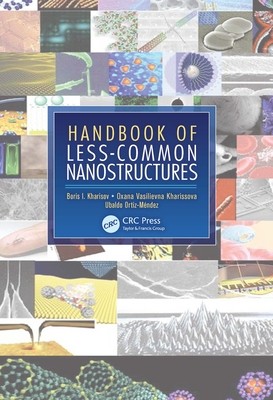
- We will send in 10–14 business days.
- Author: Boris I Kharisov
- Publisher: CRC Press
- ISBN-10: 036738163X
- ISBN-13: 9780367381639
- Format: 17.8 x 24.6 x 4.8 cm, softcover
- Language: English
- SAVE -10% with code: EXTRA
Reviews
Description
As nanotechnology has developed over the last two decades, some nanostructures, such as nanotubes, nanowires, and nanoparticles, have become very popular. However, recent research has led to the discovery of other, less-common nanoforms, which often serve as building blocks for more complex structures.
In an effort to organize the field, the Handbook of Less-Common Nanostructures presents an informal classification based mainly on the less-common nanostructures. A small nanotechnological encyclopedia, this book:
- Describes a range of little-known nanostructures
- Offers a unifying vision of the synthesis of nanostructures and the generalization of rare nanoforms
- Includes downloadable resources with color versions of more than 100 nanostructures
- Explores the fabrication of rare nanostructures, including modern physical, chemical, and biological synthesis techniques
The Handbook of Less-Common Nanostructures discusses a classification system not directly related to the dimensionality and chemical composition of nanostructure-forming compounds or composite. Instead, it is based mainly on the less-common nanostructures. Possessing unusual shapes and high surface areas, these structures are potentially very useful for catalytic, medical, electronic, and many other applications.
EXTRA 10 % discount with code: EXTRA
The promotion ends in 16d.15:28:11
The discount code is valid when purchasing from 10 €. Discounts do not stack.
- Author: Boris I Kharisov
- Publisher: CRC Press
- ISBN-10: 036738163X
- ISBN-13: 9780367381639
- Format: 17.8 x 24.6 x 4.8 cm, softcover
- Language: English English
As nanotechnology has developed over the last two decades, some nanostructures, such as nanotubes, nanowires, and nanoparticles, have become very popular. However, recent research has led to the discovery of other, less-common nanoforms, which often serve as building blocks for more complex structures.
In an effort to organize the field, the Handbook of Less-Common Nanostructures presents an informal classification based mainly on the less-common nanostructures. A small nanotechnological encyclopedia, this book:
- Describes a range of little-known nanostructures
- Offers a unifying vision of the synthesis of nanostructures and the generalization of rare nanoforms
- Includes downloadable resources with color versions of more than 100 nanostructures
- Explores the fabrication of rare nanostructures, including modern physical, chemical, and biological synthesis techniques
The Handbook of Less-Common Nanostructures discusses a classification system not directly related to the dimensionality and chemical composition of nanostructure-forming compounds or composite. Instead, it is based mainly on the less-common nanostructures. Possessing unusual shapes and high surface areas, these structures are potentially very useful for catalytic, medical, electronic, and many other applications.


Reviews